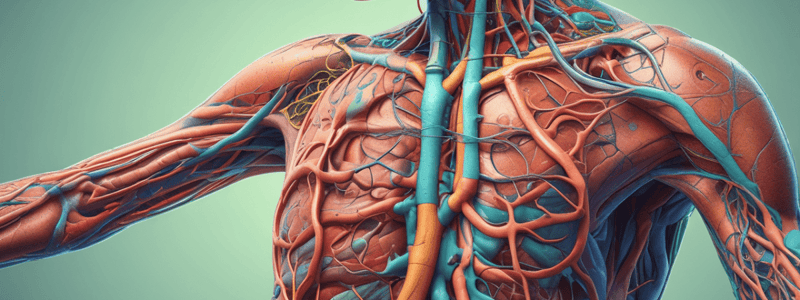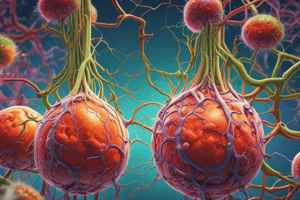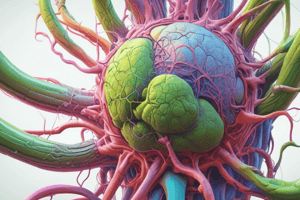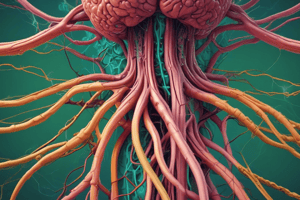Podcast
Questions and Answers
Which type of immune cell can secrete soluble antibodies?
Which type of immune cell can secrete soluble antibodies?
Which lymphoid organ is responsible for the maturation of T cells?
Which lymphoid organ is responsible for the maturation of T cells?
What is the primary function of Natural Killer cells?
What is the primary function of Natural Killer cells?
Which type of bone marrow is responsible for the development of B cells?
Which type of bone marrow is responsible for the development of B cells?
Signup and view all the answers
What is the primary function of the secondary lymphoid organs?
What is the primary function of the secondary lymphoid organs?
Signup and view all the answers
What is the main function of lymph nodes?
What is the main function of lymph nodes?
Signup and view all the answers
Where are lymphoid nodules found in the body?
Where are lymphoid nodules found in the body?
Signup and view all the answers
What is the role of dendritic cells in the spleen?
What is the role of dendritic cells in the spleen?
Signup and view all the answers
Why do tonsils swell during an active immune response?
Why do tonsils swell during an active immune response?
Signup and view all the answers
What is the function of mucosa-associated lymphoid tissue (MALT) in the body?
What is the function of mucosa-associated lymphoid tissue (MALT) in the body?
Signup and view all the answers
What is the significance of germinal centers in secondary lymphoid organs?
What is the significance of germinal centers in secondary lymphoid organs?
Signup and view all the answers
Which cells and organs destroy pathogens?
Which cells and organs destroy pathogens?
Signup and view all the answers
What is the major staging area for the development of a critical immune response?
What is the major staging area for the development of a critical immune response?
Signup and view all the answers
How does lymph move in the lymphatic vessels?
How does lymph move in the lymphatic vessels?
Signup and view all the answers
Which areas of the body lack lymph vessels?
Which areas of the body lack lymph vessels?
Signup and view all the answers
Where do all leukocytes come from?
Where do all leukocytes come from?
Signup and view all the answers
Which cells produce plasma cells that bind to antigens?
Which cells produce plasma cells that bind to antigens?
Signup and view all the answers
Which type of immune response is slower to develop but highly specific and effective at attacking a wide variety of pathogens?
Which type of immune response is slower to develop but highly specific and effective at attacking a wide variety of pathogens?
Signup and view all the answers
Which immune cell is known to release perforins and granzymes to induce apoptosis in an infected cell?
Which immune cell is known to release perforins and granzymes to induce apoptosis in an infected cell?
Signup and view all the answers
What is the function of opsonization in the immune system?
What is the function of opsonization in the immune system?
Signup and view all the answers
Which protein puts holes in the membranes of infected cells?
Which protein puts holes in the membranes of infected cells?
Signup and view all the answers
What type of antigen is specific to bacteria and red blood cells?
What type of antigen is specific to bacteria and red blood cells?
Signup and view all the answers
Which immune cell plays a central role in the inflammatory response by releasing histamine?
Which immune cell plays a central role in the inflammatory response by releasing histamine?
Signup and view all the answers
Which cells specifically induce neighboring cells to produce antiviral proteins?
Which cells specifically induce neighboring cells to produce antiviral proteins?
Signup and view all the answers
What is the primary role of cytokines in the immune system?
What is the primary role of cytokines in the immune system?
Signup and view all the answers
Which type of immune response is rapid, nonspecific, but not always effective against pathogens?
Which type of immune response is rapid, nonspecific, but not always effective against pathogens?
Signup and view all the answers
What occurs when an adaptive immune response begins to attack the body's own cells?
What occurs when an adaptive immune response begins to attack the body's own cells?
Signup and view all the answers
What is the primary function of macrophages in the immune response?
What is the primary function of macrophages in the immune response?
Signup and view all the answers
What is the main function of B cells in the adaptive immune response?
What is the main function of B cells in the adaptive immune response?
Signup and view all the answers
What is the purpose of the negative selection process during T cell development?
What is the purpose of the negative selection process during T cell development?
Signup and view all the answers
Which type of T cell is responsible for regulating the activity of B cells and their differentiation into plasma cells?
Which type of T cell is responsible for regulating the activity of B cells and their differentiation into plasma cells?
Signup and view all the answers
What is the primary function of IgA antibodies in the immune system?
What is the primary function of IgA antibodies in the immune system?
Signup and view all the answers
What is the primary mechanism by which cytotoxic T cells kill infected or cancerous cells?
What is the primary mechanism by which cytotoxic T cells kill infected or cancerous cells?
Signup and view all the answers
What is the primary purpose of the clonal expansion process in the adaptive immune response?
What is the primary purpose of the clonal expansion process in the adaptive immune response?
Signup and view all the answers
What is the main difference between active and passive immunity?
What is the main difference between active and passive immunity?
Signup and view all the answers
How do IgE antibodies contribute to the immune response against parasitic infections?
How do IgE antibodies contribute to the immune response against parasitic infections?
Signup and view all the answers
What is the primary function of regulatory T cells in the immune system?
What is the primary function of regulatory T cells in the immune system?
Signup and view all the answers




